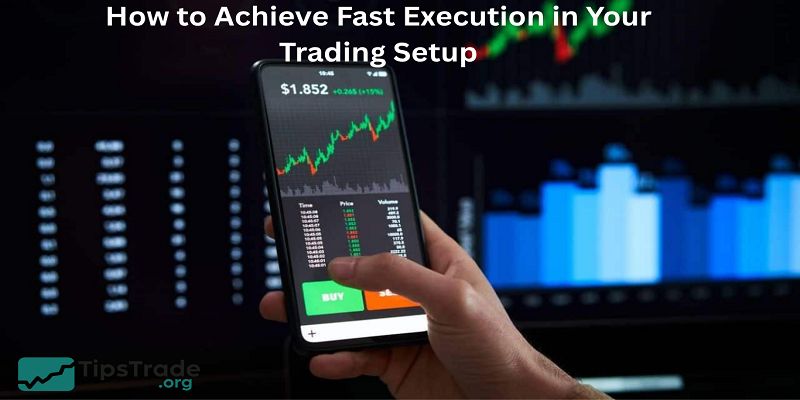Fast execution forex is a critical factor for traders aiming to capitalize on rapid market movements and secure optimal trade prices. This concept refers to the speed at which a broker processes and executes trading orders, which can significantly impact profitability and risk management. In fast-moving forex markets, delays or slippage can lead to missed opportunities or unexpected losses, making fast execution a vital feature for both beginner and experienced traders seeking precision and efficiency in their trading activities.
What Is Execution Speed & Latency?
- Execution speed refers to the time it takes for your order to travel from your trading platform to your broker’s server, be processed, and filled in the market.
- Latency is the delay in this process, usually measured in milliseconds (ms).
- In forex, even a delay of 200ms can affect whether your order is filled at the requested price or a worse one.
- There are two common models: instant execution and market execution. Instant execution attempts to fill at the quoted price, sometimes leading to “requotes.” Market execution fills at the best available price but may result in small slippage.
- Traders aiming for fast execution usually prefer brokers with ECN or STP models that connect directly to liquidity providers.
- These minimize intervention and speed up routing. Understanding latency helps traders measure whether their broker offers competitive execution speeds compared to industry standards, where top brokers average less than 50ms.
>>See more:
How Slippage Affects Forex Trades

- Slippage occurs when the final price of a trade differs from the expected entry. This usually happens in fast markets where execution is slow.
- For example, if you try to buy EUR/USD at 1.0650 but get filled at 1.0653, you’ve lost three pips due to slippage.
- That cost might seem small, but for high-frequency strategies, it quickly adds up.
- Slippage is especially damaging for scalpers who aim for 5–10 pips profit.
- Losing two or three pips per trade erases most of the potential gain. Even swing traders can be affected if slippage occurs consistently.
- According to Forex.com (2023), 99.37% of their trades execute in less than one second, minimizing slippage risk.
- Fast execution forex environments reduce these costly deviations by ensuring orders are processed at market speed.
- Ultimately, slippage cannot be eliminated completely, but with the right broker and setup, it can be minimized.
- Traders who monitor execution reports and compare brokers find that execution speed directly affects their long-term profitability.
Impact on Different Trading Styles

- Not all traders are affected by execution speed equally. Scalpers and algorithmic traders rely heavily on fast execution forex environments.
- Their strategies often involve dozens or hundreds of trades daily, with profits measured in fractions of a pip.
- For them, even minor delays or slippage turn winning systems into losing ones.
- Day traders also benefit from fast execution since they enter and exit positions quickly during volatile sessions.
- If execution is slow, they may miss key entries or exits. Swing traders, who hold positions for days or weeks, are less dependent on millisecond accuracy but still appreciate reduced costs from tighter spreads and fewer requotes.
- Institutional traders and hedge funds often go further by using co-location services, placing servers next to exchange data centers to achieve sub-10ms speeds.
- While retail traders may not access such technology, choosing brokers with ECN or DMA infrastructure narrows the gap significantly.
- Execution speed matters across styles, but its importance rises with shorter timeframes.
Key Factors That Influence Execution Speed
Broker Infrastructure & Order Routing (ECN / STP / DMA)
- The broker’s infrastructure determines how quickly trades are routed. ECN (Electronic Communication Network) brokers connect traders directly with liquidity providers, reducing latency.
- STP (Straight Through Processing) brokers route orders automatically without dealing desk intervention.
- DMA (Direct Market Access) provides direct access to interbank prices.
- By contrast, market makers may execute trades internally, which can slow down processing and increase the risk of requotes.
- According to a CompareForexBrokers study (2023), ECN brokers consistently deliver faster execution times than traditional market makers.
- Execution under 50ms is considered excellent in the retail forex space.
- Traders seeking fast execution forex setups should prioritize brokers that publish transparent execution statistics and use ECN or DMA models.
- Order routing efficiency is not only about speed but also about fairness, since transparent routing reduces conflicts of interest between broker and trader.
Server Location, Co-location & Network Quality
- Geography plays a big role in execution speed. If your broker’s server is in London but you trade from Asia with a slow connection, latency can reach hundreds of milliseconds.
- Fast execution forex trading requires servers close to liquidity hubs such as London, New York, or Tokyo.
- Co-location means hosting your trading software on a server physically located next to your broker’s or exchange’s data center.
- This reduces latency dramatically, often to under 5ms. High-frequency traders rely heavily on this setup.
- Network quality also matters: fiber-optic connections and stable ISPs reduce packet loss and jitter.
- Retail traders can’t always control geography, but many brokers offer VPS (Virtual Private Server) hosting near liquidity centers.
- For example, a VPS in London connected to an ECN broker gives faster execution than trading directly from a home computer in another continent. Choosing brokers with global server locations can significantly improve execution speed.
VPS Hosting & Latency Reduction Tools
- Virtual Private Servers (VPS) are a popular solution for reducing latency in forex trading.
- A VPS allows traders to run their trading platform on a server near the broker’s data center, ensuring faster execution and 24/7 connectivity.
- Many brokers partner with VPS providers to give free or discounted hosting for active traders.
- Latency reduction tools include ping tests, which measure how long it takes data to travel between your device and the broker’s server.
- A ping below 20ms is considered very good, while anything above 200ms is too slow for scalping.
- Traders can also optimize platform settings, removing heavy indicators and scripts that slow down processing.
- By combining VPS hosting with a broker that already has strong infrastructure, traders create a fast execution forex environment where delays are minimized.
- This setup is especially valuable for Expert Advisor (EA) users and algorithmic strategies that require constant uptime and split-second responses.
Benchmarks & Real-World Execution Speeds
Industry Data: Broker Speed Tests
- Independent studies provide useful benchmarks for fast execution forex brokers. According to CompareForexBrokers (2023), average execution times among top brokers range from 30ms to 150ms.
- Some standout performers, such as Pepperstone and IC Markets, consistently report under 40ms for limit orders.
- Forex.com reports that 99.37% of its trades execute in less than one second, with an average fill time of 0.003 seconds.
- TastyFX publishes real-time dashboards showing average execution below 17ms, offering transparency to clients.
- These numbers highlight the competitive race among brokers to deliver faster execution.
- Traders should be cautious, however, since not all advertised statistics are independently verified.
- The best approach is to test execution speed directly using small orders during active sessions.
- Reliable brokers often encourage this by publishing third-party audits or execution reports.
Case Studies & Trader Feedback
- Real-world experiences demonstrate the impact of execution speed.
- A scalper using IC Markets reported that his algorithm, which targeted 3–5 pips, became profitable only after switching from a market maker to an ECN broker with 30ms execution.
- The reduced slippage allowed his strategy to perform as backtested.
- Another case involved a day trader on EUR/USD who experienced frequent requotes with a slower broker.
- After moving to Pepperstone, where execution was consistently under 40ms, he noted tighter fills and fewer missed trades.
- However, traders also share cautionary tales. One swing trader reported that despite his broker advertising “ultra-fast execution,” spreads widened during news events, nullifying the benefit.
- These stories remind us that execution speed matters, but transparency and stability are equally important.
Risks, Trade-Offs & Misconceptions
- Many traders believe that faster execution always equals better results. In reality, there are trade-offs. Brokers advertising near-zero latency may compensate by widening spreads or charging higher commissions.
- Some offshore brokers claim instant execution but lack regulatory oversight, raising trust issues.
- It’s also a misconception that retail traders can achieve the same speeds as institutional players.
- While co-location can reduce latency to single digits, retail traders rarely compete with hedge funds running high-frequency algorithms.
- The goal is not absolute speed but fast enough execution to minimize slippage relative to your strategy.
- Another risk is assuming that VPS hosting alone guarantees success. If the broker’s own infrastructure is slow or unreliable, even the best VPS won’t help.
- Traders should evaluate the entire chain: broker, server, platform, and their own connection.
- Fast execution forex environments require balance between speed, cost, and reliability.
How to Achieve Fast Execution in Your Trading Setup

Choosing a Broker with Transparent Execution
The first step is selecting a broker that prioritizes fast execution. Look for:
- Regulation: FCA, ASIC, CFTC, or ESMA oversight ensures fair practices.
- Execution reports: Brokers like Forex.com publish audited data.
- Order routing models: ECN, STP, or DMA structures are preferable.
- Client reviews: Forums and independent sites reveal real experiences.
Avoid brokers that promise “zero slippage” or “instant fills” without proof. Instead, trust those that are transparent about average execution speeds and openly admit that slippage can occur in volatile markets.
By aligning with reputable brokers, traders place themselves in environments where fast execution is more consistent.
Optimizing Your Own Setup
- Even with a top broker, traders can improve their personal setup. Use a wired internet connection instead of Wi-Fi for lower latency.
- Close unnecessary programs that slow down your computer.
- Keep your trading platform updated and avoid heavy custom indicators that consume processing power.
- For traders in regions far from major hubs, VPS hosting is almost essential. Many brokers offer free VPS for accounts meeting volume requirements.
- A VPS near London or New York ensures execution within 20–50ms, compared to 200–300ms from a remote home computer.
- These adjustments create a more reliable environment where fast execution forex conditions are achievable even for retail traders.
- Small improvements in latency compound over hundreds of trades, making a measurable difference in results.
Testing & Monitoring Execution Speed
- Traders should regularly test their broker’s execution speed. One method is placing small market orders during liquid sessions and comparing entry prices to quoted levels.
- Platforms like MetaTrader also record execution times in the order log.
- Independent tools such as Myfxbook or broker-provided dashboards display latency and slippage statistics.
- By monitoring these consistently, traders identify whether execution speeds match advertised claims. If performance deteriorates, switching brokers may be necessary.
- Keeping a trading journal with execution data provides insights over time. For example, noting that slippage increases during news releases helps adjust strategies to avoid volatile periods.
- Proactive monitoring ensures traders operate in genuinely fast execution forex environments rather than relying on marketing claims.
Conclusion
Fast execution in forex is more than a buzzword. It’s a critical factor that influences slippage, spreads, and overall profitability. While scalpers and algorithmic traders depend most on execution speed, every trader benefits from faster fills and fewer requotes. The best fast execution forex environments combine ECN or STP infrastructure, strong server locations, low latency VPS hosting, and transparent reporting from regulated brokers. The article above from Tipstrade.org has just provided you . We hope that you find it useful. Wishing you successful trading!
>>See more:

